Since the inception of SolarSnap, Inc in 2013 it had been my personal wish to develop the digital infrastructure of our sales organization using something to differentiate our company. Given my 30 years experience specifically developing and customizing these types of application systems, I was chomping at the bit to bite into these SolarSnap digital challenges. Upon my wish list of features would be a fully integrated application with sales, installation, customer payments, source referral tracking, sales commission management, job cost and tracking, worker productivity tracking as well as a front end for our customers, outside vendors and investors to login and participate in a real time and dynamic investment process. Try to say all that in one breath!
Indeed, it has been a personal, defining purpose to develop computationally directed organizations where a carefully systematized organization maybe more fully automated through policy fulfillment at the direction of programmatic functions fully integrated at all levels of the organization. This would essentially do away with many of the management positions of the organization, being thereby replaced by computationally derived automations and implemented through the almost absolute Internet connectivity and real time data of telemetry, finance, delivery, production and satisfactions. I envision that a more programmatically run organization shall be greatly streamlined and more lightweight. This shall open the door for the possibility of cooperative companies of like-minded, self empowered individuals who perform more in a partnership role than the more subordinated model currently predominating in business today. SolarSnap then becoming the laboratory for such an innovation in this sort of science of business.
In beginning this journey in developing such a system, I started by assessing the immediate functional requirements of the organization standing before me. Essential basic driving needs were the factors of knowing exactly what are our profits per job; knowing that the customer would like to see and track what is happening real time with their solar installation project; wanting to assure that sales people are paid promptly for their hard work; and as executives we like to know who is least and most productive. Dreaming a bit higher, I also hoped to pioneer a new technological system to extend solar lending opportunities to allow people with extra cash to access the system and bid on lending opportunities. This would allow investors to participate in financing solar projects while making a decent financial return as these opportunities came about in real time with new customers. It seemed that only a custom built, total information solution would work to drive and integrate our organization, fully satisfying our workforce, customers, executives and investors.
What we got, initially, instead was a canned, off-the-shelf solution that was designed primarily for fledgling companies hoping to show some kind of information technology to speak of. Bending to the times, and in lieu of not having the luxury of 6 months of my time to develop a real, scaleable, enterprise-wide networked system, the open source software Odoo (formerly OpenERP) was chosen based on the reality that it was the only real option available to us at the time.
I first implemented Odoo in the year 2014 on a server at our factory location in the Industrial Park. Odoo featured a server based application allowing connectivity anywhere, customer database, invoice generation and some, limited financial capabilities. There was no mobile capability, and it was an everything-for-everyone, while fully satisfying no one, solution with more features, modules and data, like everything in a taco including the kitchen sink! Almost immediately, the sales crew tore out the invoice from Odoo and began making their own Odoo look-alike invoices in the Excel spreadsheet program. So much for team adoption!
Upon bringing protest to my sales workers, I was given a whining chorus about the difficulty of quickly making a customer quotation in Odoo. It was then demonstrated to me that trying to complete this one simple invoice generation task, was indeed an awkward and tedious process. Just to quickly generate an invoice to go with a quotation was indeed a necessity that we could not go without. In an effort to appease and free-up my sales force, I allowed them to abandon Odoo in favor of greater efficacy, and continue making their invoices in Excel. Then, thrown out the window was our executive tracking, sales lead tracking, customer login, installation integration, job tracking and pretty much everything on my wish list. To our worker’s credit, our company sales numbers grew quickly over the following three years without having the burdens of doing gymnastics to complete a few simple digital tasks required to close a sale.
It would not be until the summer of 2018 that I would finally have the time and opportunity to sit down to devote the 500+ hours required to develop the aforementioned, comprehensive total system for the SolarSnap organization. Based on my app dev experience and my now over 7 years time logged running the SolarSnap retail stores division, I had a pretty good idea where I wanted to start. I knew what I wanted based on the aforementioned wish list, but what I needed to do first was to invent the organization of my dreams beginning with the future first and then rolling back to the present moment. Looking out ahead using a bit of imagination, I saw a fully integrated and well managed enterprise with thousands of workers, collaborating together, often at a distance, with great efficiency. But, who would run this organization and what would they do exactly?
I then began by describing and carefully defining each of the job roles within the sales organization for our SolarSnap Stores Corp. I held a series of meetings with my then executive assistant/co-manager, Ms. Lily Martinez, to compare notes and develop this ideal business structure. What emerged was an organization divided into 6 distinct areas, each given a color code, and each with an user type number to define their access within the application for the organization.
The department color coding for all those working within this organization of our dreams would be the following:
orange for management, blue for the sales team, green for the service techs and installers,
red for the external installers, electricians and construction,
yellow for customers, and
hunter green for investor. The job and user titles for the company that we then developed were as follows (user_type numbers in parenthesis):
President (1.1), Vice President (1.2), Section Chief (1.3), Regional Supervisor (1.4), Regional Accountant (1.5), Assistant Supervisor (1.5), Sales Manager (2.1), Sales Executive (2.2), Service Manager (3.1), Service Pro (3.2), Service Tech (3.3), External Part-Time Sales (4.1), External Installer (4.2), External Electrical (4.3), External Construction (4.4), Retail Customer (5.1), Corporate Customer (5.2), and
Investor (6.1).
I then worked full-time for the next 6 months to write the software for this new system using the standard open source development tools for Internet server deployment (PHP, MySQL and web hosting on a UNIX server platform.) Thus became the genesis of our new, fully integrated application, that we dubbed SIS:
SolarSnap Information System (or, en espanole
Sistema de Informacion de SolarSnap). Upon login to SIS each user is presented with a custom screen (user interface) designed specifically for them to allow them to immediately see the most important information and to efficiently accomplish their tasks to communicate, direct resources, view progress and, oh yeah, quickly generate an invoice!
Accent hints are offered in trim colors to match the user type color coding scheme. Tasks can be accomplished just as easily on a mobile device such as a smart phone, as can be done on a desktop or laptop system. Users may now work intuitively, from almost anywhere, to accomplish their specialized tasks together as well as those working and acting externally such as customers, external sales, external installers and investors. Customers are now able to access their installation project, invoices and notes made by their installers, but only see their invoices and installation projects where appropriate. External sales workers may now quickly input a new sales lead, upload a CFE bill, then see and track their customers throughout the life-cycle of the sales and installation process.
Unlike Uber and other apps, no application download or installation is required to utilize SIS. Simply navigate to
https://sis.solarsnap.com in any web browser and login to the application. SIS is accessible using Android, Windows, iOS, MacOS, Linux or virtually any operating system with a web browser. SIS works just as well with mobile devices as it does with desktop and laptop systems due to the responsive design elements employed. SIS utilizes mobile friendly, feature rich HTML5 technology now fully integrated into all mobile and desktop devices. Currently, SIS is user configurable to work in either Spanish or English, but other languages shall be added in the future as we expand our organization out of the Americas.
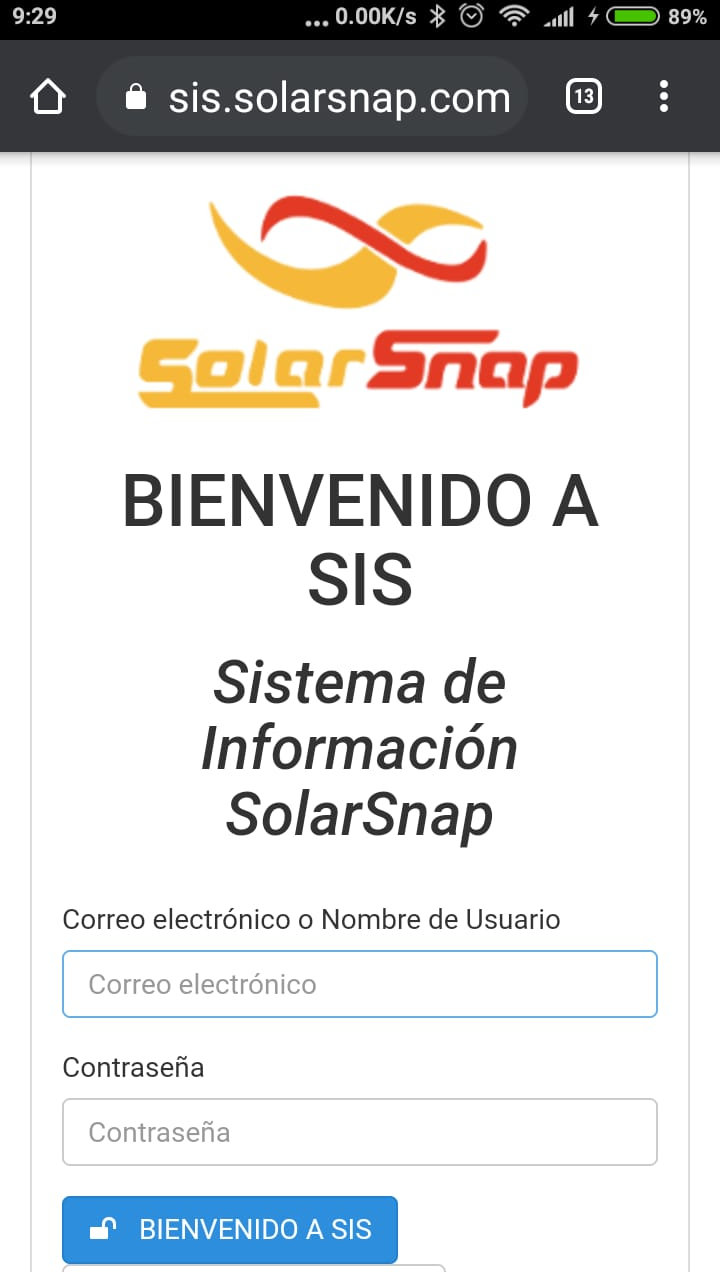
SIS Login
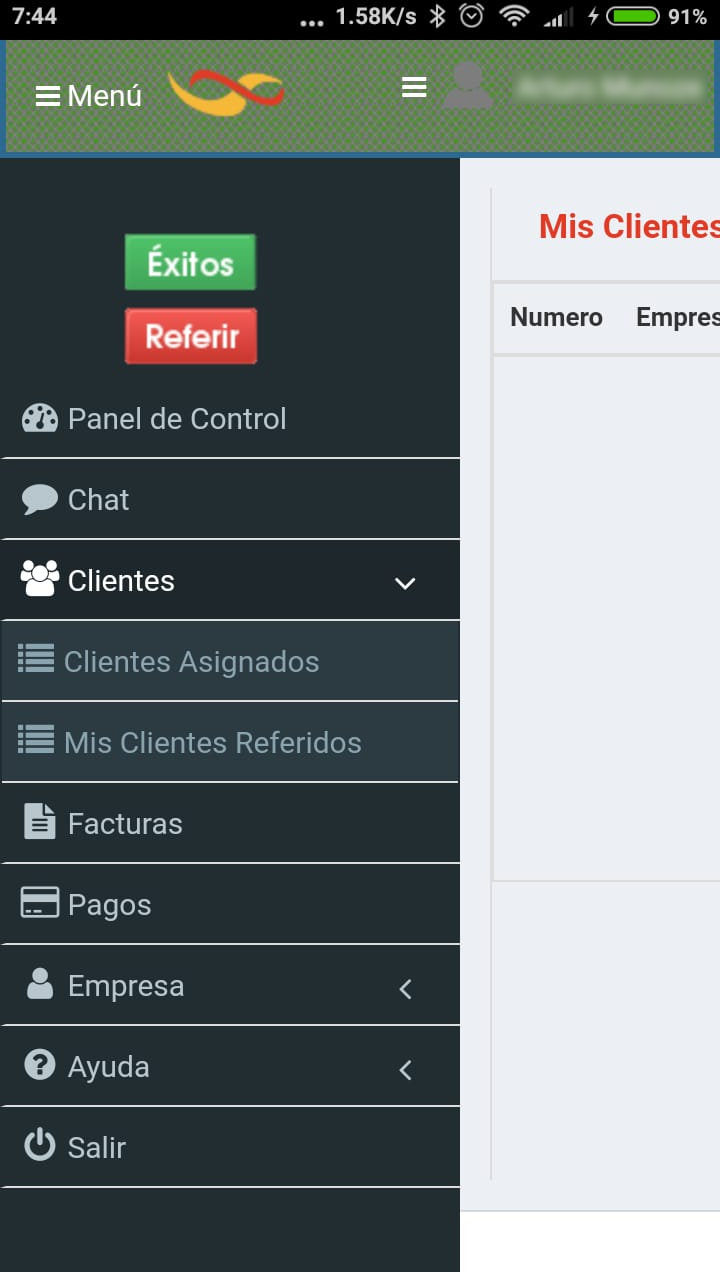 | | | | SIS Main Menu for Investors. Note hunter green trim consistent with Investor color code |
|
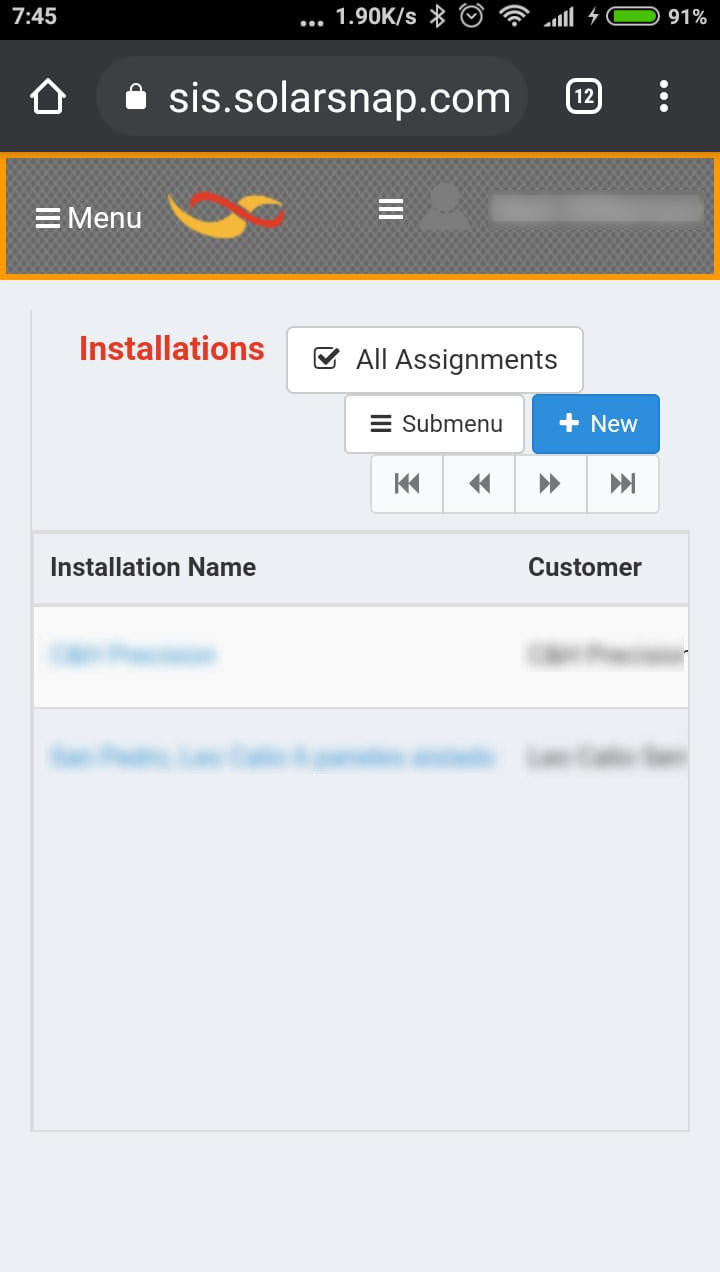 | | | | Installation Projects For User Type Manager (orange trim) |
|
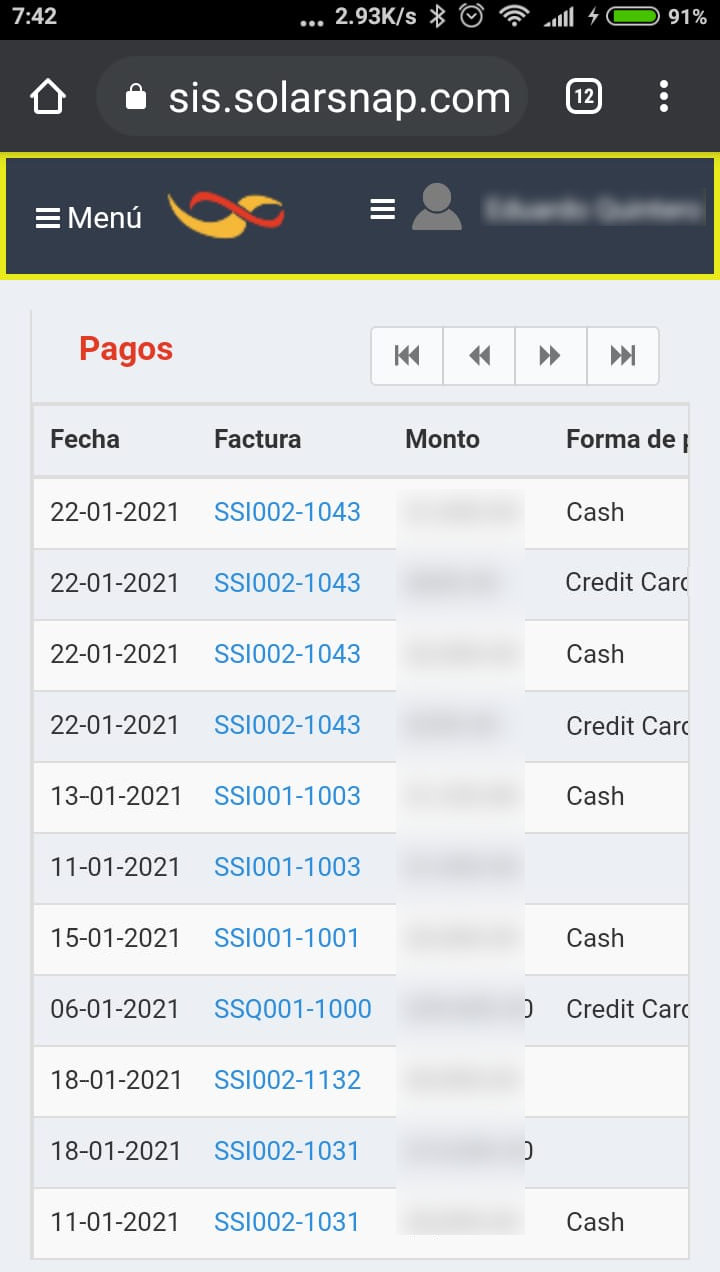 | | | | Customer Payments
For Logged-In Customer (yellow trim) |
|
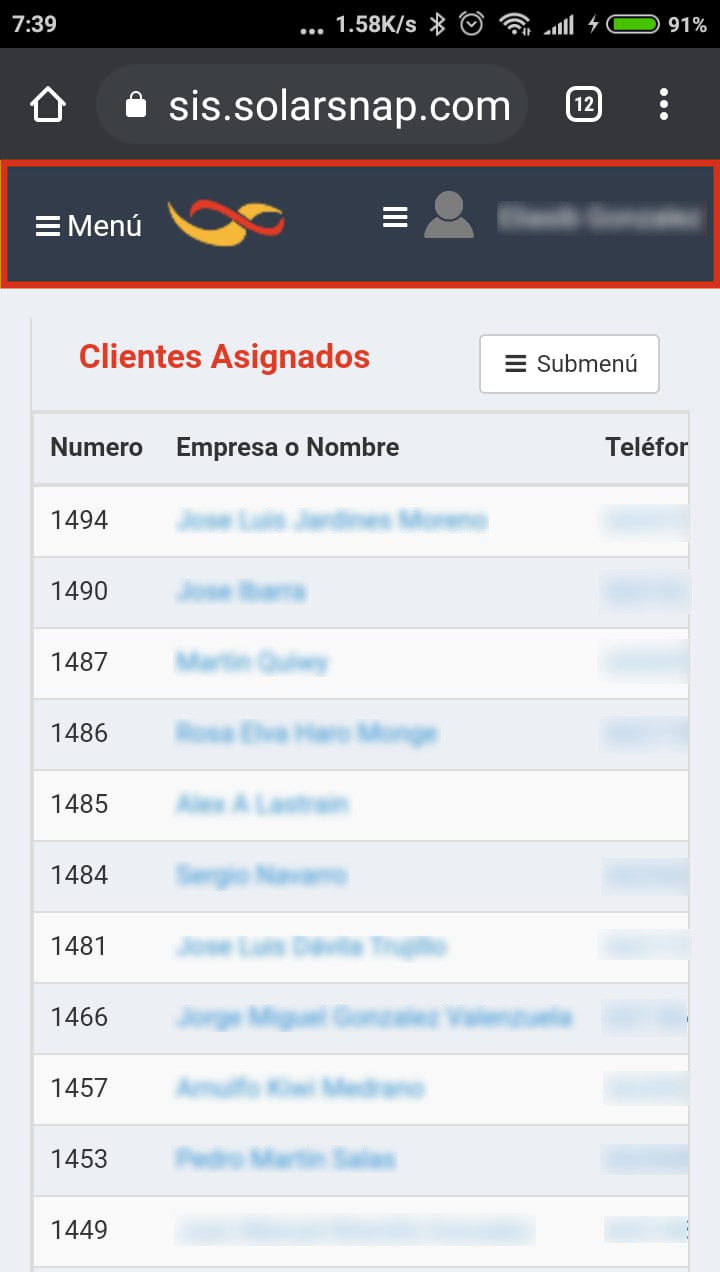 | | | | Referred Customers, External Sales User (red trim) |
|
These are just a few examples of interface screens for specific user types. There are hundreds of others, in total given the myriad of combinations, and many new ones being added on-goingly. The future vision for the app and the company is to integrate the total workforce, customers and investors within our new organizational business model. This model features our retail sales business being conducted largely over the Internet, with follow up from our centralized sales organization and complete order kits then shipped direct to the customer from our fulfillment centers with follow up by independent and fully qualified installers being managed largely through the App, to complete the installation projects. Virtually all workers within the entire organization shall be connected, informed, managed and compensated through the new App system which ties the entire organization together.
Thank you for reading!






